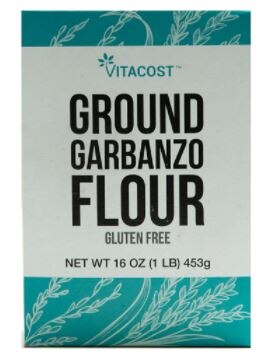All purpose, whole wheat, gluten-free, chickpea? There’s a new flour in town and it’s time to check it out. Chickpea flour actually isn’t new at all and is in fact a staple in many cuisines. You may have seen it referred to as gram or besan flour in many delicious Indian recipes we already know and love. Pakoras, besan roti and besan ladoo are just a few examples of these unique recipes. However, chickpea flour is finally getting the attention it deserves and is now being added to all sorts of recipes for added flavor and nutritional value.
![How to Make Chickpea Flour + the Benefits Bowl Filled with Chickpea Flour Next to Bowl Filled with Dried Chickpeas | Vitacost.com/Blog]() How to use chickpea flour
How to use chickpea flour
Chickpea flour is a great source of protein and fiber, and can be an easy gluten-free swap for normal wheat flour. If you already eat gluten-free, chickpea flour can be a great replacement for bland rice and corn-based flours. Chickpea can be used almost as a 1-1 replacement for flour in many recipes, or can stand out on its own. A good rule of thumb for substitution is ¾-7/8 cup of chickpea flour to 1 cup of al-purpose flour.
Chickpea flour is naturally dense, so it holds together really well in handled foods like tortillas or flatbreads, or as a binder in fritters and veggie burgers. It can also be snuck in sweets, and does well in brownies, breads and even pancakes. Feel free to get creative with this one, it will be pretty hard to mess up!
Benefits of chickpea flour
Focusing more on nutrition, chickpeas truly do have it all. As mentioned before, they are packed with protein and fiber, with one cup of flour offering 20 grams of protein and 10 grams of fiber. On top of this, they are a great source of iron, magnesium, manganese and other vital minerals. But wait there’s even more. Chickpeas are also high in folate, and one cup of flour provides 100 percent of the recommended daily amount. Folate is important for everyone, but especially for pregnant women, and is essential to ensuring proper neural development of the baby. So basically, whether you’re pregnant or not, you will definitely benefit from adding chickpea flour into your meals.
Where to find chickpea flour
You can find chickpea flour online at Vitacost.com or in most stores, but making your own at home is the best way to go. All you need are some bulk dried chickpeas, so you will be saving a lot of money by turning this into a DIY. Not to mention, there is something very rewarding about using homemade flour in recipes, especially when you know the flour is a nutritional powerhouse. The recipe below gives a step by step (don’t worry, there’s only three) on how to make your very own chickpea flour at home.
How to make chickpea flour
Ingredients & equipment
- Dried chickpeas
- Heavy duty blender, food processor or coffee grinder
- Mesh strainer
Directions
1. In food processor or blender, blend dried chickpeas on high for a few minutes until it reaches a flour-like consistency. If using a coffee grinder, you will have to do this in batches.
2. Use mesh strainer to sift flour through a mesh strainer (the finer the better) to get a smooth consistent texture.
3. Store sifted flour in an airtight container in a cool area for up to 8 weeks (longer if refrigerated).


